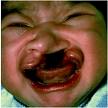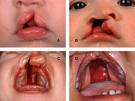|
|
|
HomeNDCOnline CoursesASVAB PracticeUSAF PDG TestsUSVCP StoreDischarge CertificatesVeteran Directory2016 Comp RatesSMC RatesEmergency Data CardVeteran ID CardLuggage ID CardDisabilitiesBusiness DirectoryVerify ServiceBenefits NewsComp QuestionsCompensation NewsHow to WinVet CentersVSO DatabaseVA Regional OfficesState BenefitsSVC CompensationCompensation FAQsAgent OrangePsych CompMST CompensationRare CompensationLocate War BuddyMedical RecordsStressor LettersFormsBrochuresFREE GuidesVideosPress ReleasesContact UsMembershipUpcoming EventsDiscountBizArchive RecordsHomeless AlertSubmit ArticleVSO of the YearClassifiedsAbout USVCP
|
Cleft Lip and Cleft Palate Cleft lip and cleft palate are among the most common
birth defects, affecting about one in 700 infants a year in the United States. A cleft is an opening or a split in the upper
lip, the roof of the mouth (palate) or both.
Cleft lip can affect one or both sides
of the upper lip. Cleft lip and cleft palate commonly occur as isolated birth defects, but cleft lip and cleft palate also
are associated with many genetic conditions.
The look of a cleft lip may be startling
to you at first, but know that cleft lip and cleft palate are correctable through surgery. In most babies, doctors can correct
the defect and restore normal function with minimal scarring for your child. Symptoms Usually, a cleft — or split — in the lip or palate is immediately
identifiable at birth. Clefts can appear as only a small notch in the lip or can extend from the lip through the upper gum
and palate.
Less commonly, a cleft occurs only in the muscles of the soft palate (submucous cleft), which is at the back of the mouth and covered by the mouth's lining. Because it's hidden, this type of cleft may not be diagnosed until later.
[ Back ]
|
|
|
|

